Japanese style in landscape design: auxiliary elements
In Japan, it is customary to delimit space. Including on the site. Even the paths have their own fences, as well as ponds, bridges, teahouses and any playgrounds. The Japanese avoid high blank fences, and their plots are often fenced off with low palisades. One of the popular Japanese-style fences is a wicker fence.
If it is planned to be made of stone, then the blocks are fastened with a special solution. Lattices and wooden slats are traditionally tied with plant fiber ropes. The main goal is to lighten the structure and easily replace the components.
Japanese-style paths became relevant in the 17th century, when tea gardens began to appear in Japan, with tea houses that became famous all over the world. Due to the fact that the guests were supposed to be imbued with an atmosphere of calm and concentration, the paths were made very winding and long, and it was only allowed to step on stones set on the ground. These are tobiishi - step-by-step paths. They can turn into stone paving in certain areas. Later, gravel paths appeared, and some gardens began to function as walking paths.
A Japanese-style flower bed should not be replete with bright colors and different varieties of plants. The Japanese prefer calm greenish tones and unusual flowers. They plant weeping willow, maple, pine, plum tree in the gardens. Sometimes trees grow in the form of bonsai. But the most famous were the flower beds created entirely of stones.
History of appearance
The Japanese style in landscape design appeared a long time ago: almost one and a half thousand years ago. It is closely intertwined with the history of the culture of the land of the rising sun. For a noble Japanese or a Japanese woman, possession of a heightened sense of perception of the aesthetic side of the world was one of the main advantages. Formed under the influence of this, the principle of "the charm of things" - monono avare - played an important role in the life of people of that time.
A typical example of early Japanese gardening art is the Imperial Palace (7th century) in Heian. The nature of the landscape park was formed under the influence of China, but was endowed with its own special idea and sought to preserve naturalness. The assortment of plants included flowering ornamental trees and shrubs such as cherry, plum, azalea, sakura, kerria, irises and chrysanthemums. Even then, when choosing plants, the Japanese were guided by their symbolic meaning: pine - longevity, bamboo - resilience, etc. Such landscape elements as mountains and rivers, which are present in their reduced copies - hills and streams, lakes and islets, participate in the garden. In connection with the growth of the population and the density of buildings, inner gardens - tsubo appear, which fit into the architecture of the house. It was not customary to invade them, and also to walk on them, one could only admire them.
With the founding of the new capital, Kyoto, the so-called tea ceremony gardens were formed (IX-XII centuries), which were arranged right in front of the tea house.
 Tea ceremony garden
Tea ceremony garden
In the XIV-XVI centuries. the garden has become an indispensable element of the temple complex. Gradually, decorativeness faded into the background, giving way to symbolism. The bright colors of flowering are replaced by a monochrome and strict color scheme. Water in lakes and streams is sometimes replaced with pebbles and sand, this technique is called kare san-sui - "dry landscape".
 "Dry landscape"
"Dry landscape"
The borrowed Chinese style of gardening has been transformed over time into its own, Japanese landscape design. A large landscape park for free time is transformed into a miniature conceptual garden, the purpose of which is to calmly contemplate and improve the spirit.
Characteristics
All Japanese gardens share common features.The landscape designer always works within these canons, showing his imagination only within the traditional rules. A Japanese-style garden combines minimalist forms and plants with restrained colors. A laconic approach is reflected in the location of objects in the landscape. The quantitative proportions between evergreen and deciduous plants should be three to seven, respectively. The subtle philosophy of the Japanese garden is symbolism in every detail. Countless signs and beliefs are associated with trees and interior items, which have evolved over the centuries and are a reflection of Japanese culture.
 Calm and tranquility
Calm and tranquility
The main rule when creating a Japanese style is to adhere to natural naturalness, for example, a tree that lives in a mountainous area cannot be planted next to water. In order for the landscape design to be natural, it is imperative to draw up asymmetric compositions according to the rules:
- the shape, color and position of the plant cannot be repeated;
- imaginary lines that connect objects in the garden cannot be the same length, nor can they be parallel.
Japanese gardens in abundance contain a variety of small architectural forms that can be used to create additional entourage: wooden or metal gates and wickets to separate one part of the garden from another, clay and bamboo walls and fences, which can be decorative. and functional load, tsukubai - a stone bowl for washing hands, a bamboo rotating shikaodoshi tube through which a thin stream of water flows, lanterns, pagodas, bridges and gazebos.
A classic Japanese-style garden can be presented in several forms:
a tree garden is the closest to natural landscapes. Mixed species of deciduous and evergreen trees and shrubs are used in such gardens (see below for more information on plant species). A decorative shearing is often used, with the purpose of molding only to slow down the growth of plants. They are never given the whimsical and unnatural shape of regular European gardens;
a rock garden is a sacred place endowed with a deep meaning. Stones can symbolize mountains, islands of immortals, estuaries, etc.
When choosing stones, special attention is paid to shape, location, color and luster. As you might guess, preference is given to neutral and simple specimens.
An important factor is the number of stones placed and their balance;
Tsubo garden - a mini-garden, usually with an area of 4 m2 to 10-15 m2. It can be located in the open air and inside the house, being part of the interior. With such a small size, brevity plays a major role.
In closed gardens, it is important to take into account the light regime and select plants in accordance with this regime: only the tsubo, located on the south side, can be "populated" with light-loving plants. The surface of the ground can be paved or covered with white pebbles, combined with lawn or moss
At the same time, it is important to consider drainage so that excess water does not interfere with the development of plants. To place accents in the garden, light sources are added that should not be conspicuous;
tea garden. It can be natural landscape, private, dry or flat - hiraniva garden. Abstaining from luxury and pretentiousness is important. The atmosphere of peace and tranquility inherent in the essence of Japanese tea drinking should reign here, therefore, planting brightly flowering plants is undesirable. Traditional elements of such a garden include a tea pavilion, a bench, a lantern, tsukubai (from the Japanese verb "squatting down") - a vessel for ablution, a well for scooping up water, a gate dividing the garden into inner and outer, and tobiishi - a path laid in according to the step width.
Korean garden style
They are another example of using the principles of landscape design style. Initially (like the Japanese ones), being influenced by Chinese trends in landscape design, they eventually acquired their unique character, filled with elements of Korean culture and traditions.
For the classic type of landscape gardening areas in Korea, the following details are characteristic:
- stones;
- evergreen trees and plants - mainly Korean cedar and bamboo;
- natural streams, waterfalls;
- artificial ponds with dark green or almost black water (in contrast to the reservoirs of private parks in the West, where the most preferable color of water is blue).

An interesting feature of Korean gardens and parks is the local fauna, represented by an amazing variety of exotic birds and animals. According to national beliefs, they, like nothing else, emphasize the naturalness and beauty of natural landscapes.
It is curious that not only elements of wildlife, but also man-made objects - stone figures of animals, birds, fish, all kinds of faunistic compositions, etc., organically fit into the general picture of Korean parks.
The most famous surviving classic examples of Korean gardens are represented by three ancient complexes:
- Fort of Baekje period near Seoul;
- Goguryeok Garden (near Pyongyang);
- Anapchi Pond (Gyeongju National Park).
Landscape style
The landscape style in landscape design is complete naturalness and the absence of strict and regular geometric shapes and figures.
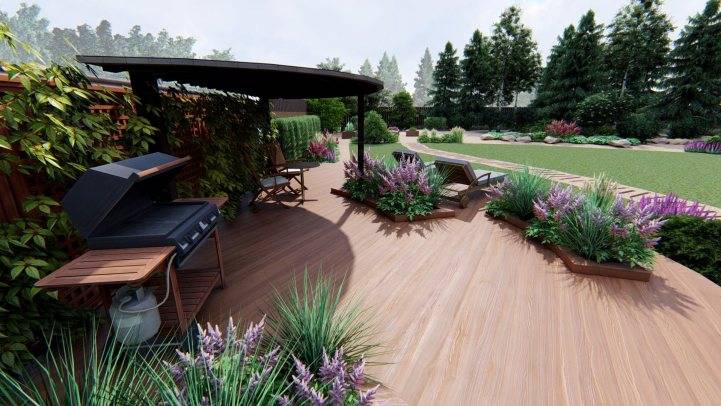
Here, work to improve the landscape is being carried out as unnoticed as possible. Such a garden is distinguished by a combination of romance and rationalism, elegance and solemnity.
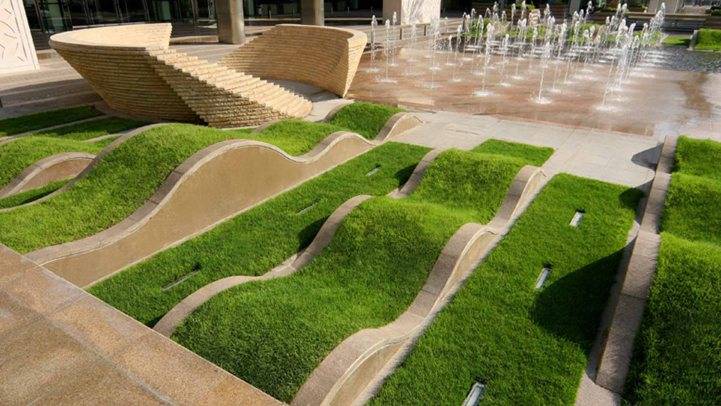
This style reproduces the spirit of 19th century English manor houses. Therefore, it is often called the English style.
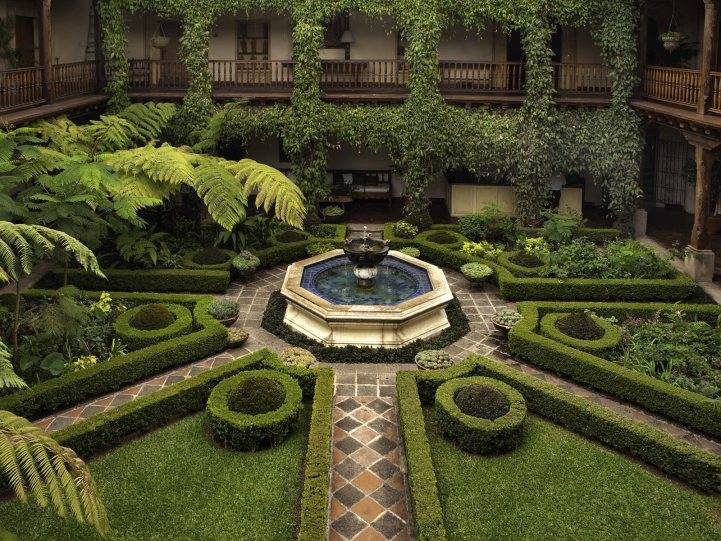

The most important element of this style will be a carefully manicured lawn (which will have to be monitored almost daily), vertical gardening with the help of vines.
All kinds of flowers create lovely flower beds, neat thuja or juniper, jasmine or elderberry are grown from shrubs.

Small ponds with bridges, natural benches, gazebos, arches are used as an additional decoration.

The landscape style should leave the impression of a slight disorder.
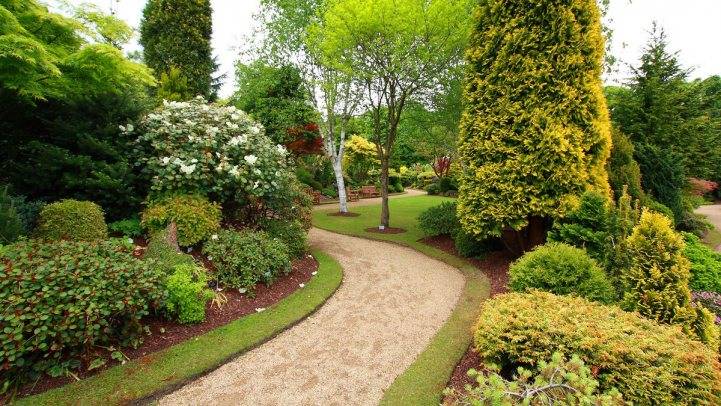
It is better to embody it on plots of more than 12 acres. In a more modest English-style garden, it is better to decorate only part of the territory.
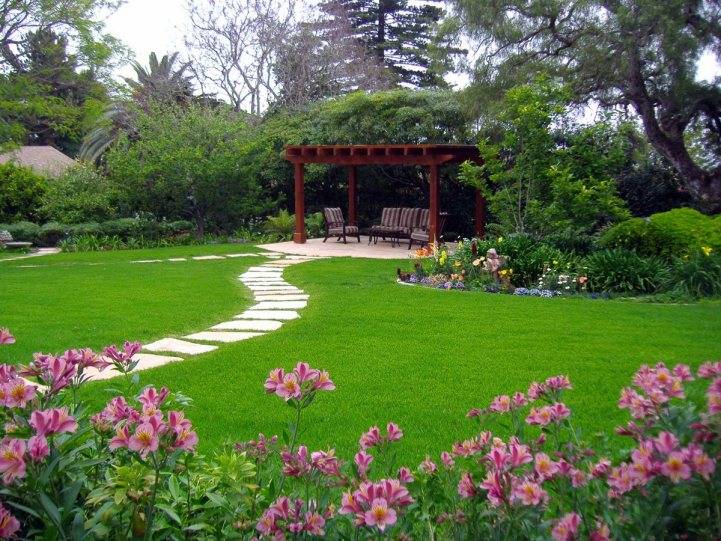
Persian Gardens
A group that brings together various types of gardens in Iran and some other countries of the world, made in accordance with the traditions of Persian gardening art. The main idea of their creation was the personification of paradise on earth - a place where a person could hide from the bustle of the world, be alone with his thoughts or spend time at a leisurely conversation with his close circle.
The inherent characteristics of the classic type of Persian gardens are:
- an abundance of sunlight and the use of special effects that emphasize its importance;
- the use of objects that provide shade and protection from the sun - trellises, walls, partitions;
- various water bodies (natural and artificially created) and irrigation systems;
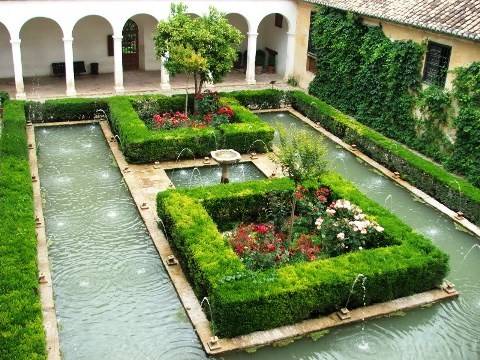
- architectural elements that unite disparate, isolated areas of the territory - vaults, arches, etc.;
- an abundance of plantations - trees, shrubs, flowers, ornamental plants.
It is noteworthy that both formal and landscape style techniques can be used in the organization of such landscapes.
The most famous example of a traditional Persian garden is the Taj Mahal, located in Agra, India. Despite the fact that this historical and cultural site is located outside Iran, its organization clearly demonstrates the main canons of a special planning style characteristic of Persian gardens - the so-called. "Charbag" ("chaharbag").
This style of landscape design provides for the division of space into four rectangular parts, separated by paths or channels with running water.
Garden design options from Real Gardens studio
Japanese garden
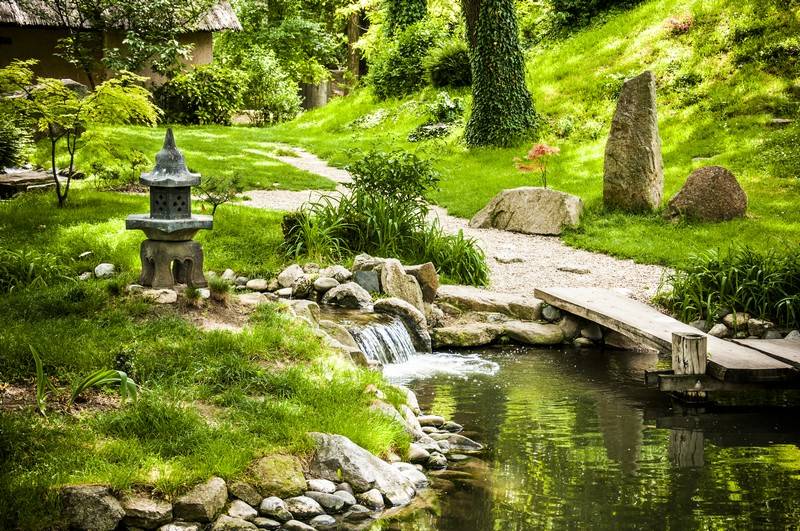 Landscaping in the style of a Japanese garden is the personification of tranquility and tranquility. The atmosphere of the territory, designed in this way, disposes to contemplation of the beauty of nature, philosophical thoughts and meditations in silence. Each detail is filled with its own inner meaning.
Landscaping in the style of a Japanese garden is the personification of tranquility and tranquility. The atmosphere of the territory, designed in this way, disposes to contemplation of the beauty of nature, philosophical thoughts and meditations in silence. Each detail is filled with its own inner meaning.
The central element of Japanese landscape design are compositions of stones arranged in a certain way, as well as paths that imitate waves. Plants should also emphasize the general purpose of the miniature garden.
For this purpose, trees and shrubs are used that vividly react to the change of seasons and focus on this natural phenomenon. Best suited for this are azalea, camellia, plum, Japanese pine and, of course, bonsai
French garden
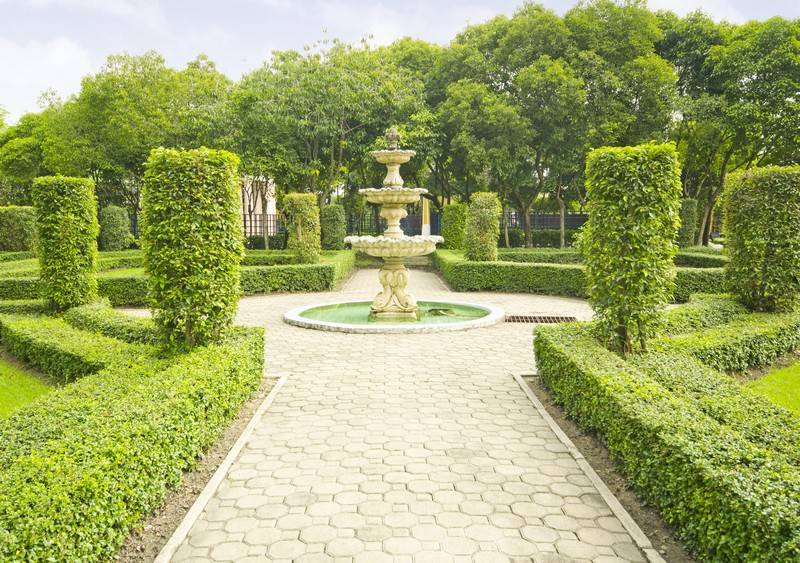 The landscape design of the garden in the French style is characterized by straight clear lines and forms, solemnity and grandeur. Its distinctive features are:
The landscape design of the garden in the French style is characterized by straight clear lines and forms, solemnity and grandeur. Its distinctive features are:
- Straight tracks;
- Alleys of symmetrically planted and evenly trimmed shrubs and trees;
- Reservoirs with geometrically regular shapes.
Most often, the landscape design of a French garden is complemented by fountains, small canals, sculptures, and hornbeam-shaped walls.
English garden
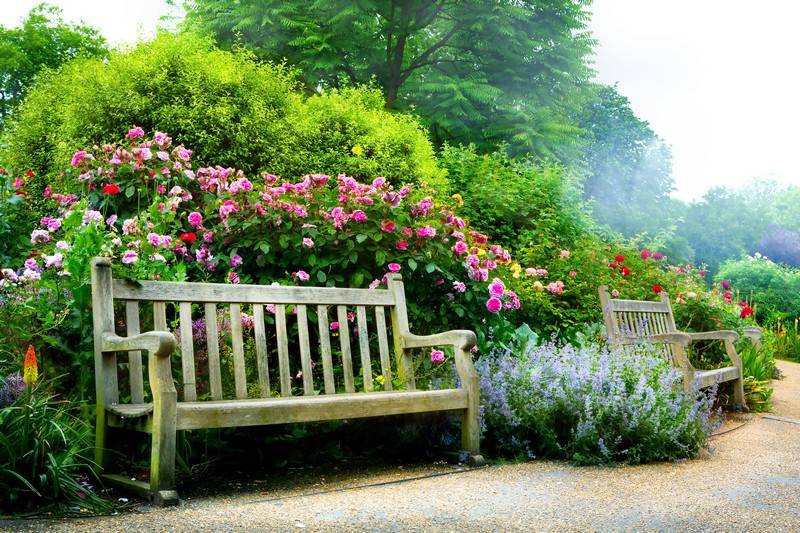 Garden landscape design in the English style is laconic, natural and simple. All elements and design details should harmoniously fit into the pristine landscape. Smooth green lawns in such gardens are complemented by lonely standing large trees or small compositions of them. Most often oak, beech and hornbeam are used for this purpose.
Garden landscape design in the English style is laconic, natural and simple. All elements and design details should harmoniously fit into the pristine landscape. Smooth green lawns in such gardens are complemented by lonely standing large trees or small compositions of them. Most often oak, beech and hornbeam are used for this purpose.
Often in the English garden you can find ponds and natural streams. It is also considered traditional to create a hedge or arable land. An indispensable element of the composition is a secluded corner with a bench or a quiet seating area with a gazebo.
Rustic garden
 Landscaping of a garden plot in a rural style is sometimes called a summer cottage. It is characterized by the use of natural materials and fairly simple, discreet plants. In such a territory, you can find a variety of perennials and annuals. A motley mess obeys a premeditated design idea, but sometimes it results from the fact that plants reproduce by self-sowing. The shape of the landscape is adjusted with minimal changes in the form of paths made of ordinary stone.
Landscaping of a garden plot in a rural style is sometimes called a summer cottage. It is characterized by the use of natural materials and fairly simple, discreet plants. In such a territory, you can find a variety of perennials and annuals. A motley mess obeys a premeditated design idea, but sometimes it results from the fact that plants reproduce by self-sowing. The shape of the landscape is adjusted with minimal changes in the form of paths made of ordinary stone.
A type of rural garden is a country-style landscape design. This option is distinguished by the use of local crops in flower beds, planting fruit trees and shrubs, as well as decorating the landscape with improvised means.
Art Nouveau garden
 The landscape design of the garden in the Art Nouveau style is characterized by the smooth lines of the layout, pronounced individuality, a variety of forms and symbolism. Often, when creating such projects, designers use frame and monolithic structures made of modern materials, for example, metal or plastic. Of course, there are also elements of stone and marble.
The landscape design of the garden in the Art Nouveau style is characterized by the smooth lines of the layout, pronounced individuality, a variety of forms and symbolism. Often, when creating such projects, designers use frame and monolithic structures made of modern materials, for example, metal or plastic. Of course, there are also elements of stone and marble.
Landscaping in the Art Nouveau style is distinguished by elegance and unpredictability. These gardens are decorated with cobblestone paths, paving slabs or natural stone. They often have terraces, or add a pool to the landscape design. Usually there are few plants in such gardens, but their placement is very carefully thought out. Preference is given to local tree species, for the middle lane these are birch, linden, willow and ash.
Chinese style in landscape design
The history of the development of gardens in the Middle Kingdom goes back centuries. Back in the 200s BC. NS. during the reign of the first emperor of the Qin dynasty, the imperial park was created. Here, in addition to the Chinese flora and fauna, miniature copies of lakes, mountains, landscape features of the conquered countries were made.

The universe park was filled with plants and animals from all the corners available to the Chinese at that time. By the 5th-6th centuries, parks and gardens were laid out everywhere - in the homes of scientists, officials, soldiers and poets, merchants and commoners. One of the traditions that have come down to our times is the combination of stone and water, associated with the World Ocean and the World Mountains.
Did you know? One of the popular attractions in Beijing is Beihai Park. Tourists are amazed by the vast territory, designed on the basis of the legends about the Island of Immortal Taoists, as well as the imperial cuisine, where they cook according to the recipes of the Qin dynasty.
Registration rules
In the classical style, the territory is divided into separate zones with different content. From one corner, a view of the next section opened. Reception of the "screen", i.e. the lack of the ability to cover the whole picture creates the impression of a space without borders. And in the past, the ancient Chinese used it as a defense against evil spirits.
The main focus is water and stones, trees, flowers and shrubs most often grow naturally, occasionally subject to human intervention. Trimming is carried out as needed, and not to give certain contours.

The first rule of planning is that all details should be arranged according to feng shui:
- The South is a territory of love and emotional uplift. The presence of elements of the fire element (lanterns, especially red) is required.
- North - career, work ideas and projects. Emphasis on water, stones, the presence of dark colors.
- The eastern zone embodies science, reflection and learning new things. The emphasis is on plants and wooden elements, green color.
- West - friendly meetings, warm gatherings. There should be gazebos, metal objects, light, white tones.
All paths between the zones and leading to the house are made winding, with curvatures, which allows you to eliminate hostile energy. The material for the paths is gravel, stone, tiles.
Important! According to Chinese philosophy, the movement of energy in space is serpentine. Therefore, straight lines are not allowed, they are negative.
Main elements
The main details of the garden:
Decorative stone walls inside the garden serve as a support for plants and complement the composition. On the practical side, they delimit the space.
Moon Gate. An opening or an arch in human height reveals the neighboring landscape. It can be made of metal with an openwork pattern, stone or wood.
Stones. Ideally, it is desirable to find boulders, cut by water for many years, irregularly rounded, oval, holes are welcome. They are located both singly and in a group.
Water. Mini lake, pond, stream, waterfall - everything is welcome
It is important to have both standing water and moving water. It is great if there are small fish and aquatic plants.
Bridges
Any sizes and shapes: 1-2 steps, straight, curved. The material for the manufacture is stone and wood.
Gazebos or pavilions. With a fancy curved roof, no walls, sheer or translucent curtains can replace them. Usually, in the center of the reservoir or on the shore.
Bonseki is a stone garden. The composition is placed on a large pallet with sand or fine gravel. Natural materials (stone, sand, wood, bird fluff and feathers) are used to create a mini-landscape, for example, a mountain peak in the clouds.
Chinese lanterns. Made of metal, glass, wood, thick paper. Hieroglyphs are depicted on the edges, the main color is traditionally red.
Entrance gate.In the shape of a rectangle, complemented by a patterned roof, painted in brown or red.
Sculpture of a lion made of stone. Necessarily a couple, located at the entrance gate. Their function is to protect the wearer from negative energy.
 The complex has many different interior items, sculptures and landscape compositions.
The complex has many different interior items, sculptures and landscape compositions.
Plant selection
In a Chinese garden, there must be bamboo - a symbol of perseverance, pine - the personification of longevity. Among other plants, both flowers and fruit trees, such as peach or plum, are important, bringing joy.
Check out
Tulips and daffodils in landscape design
Suitable representatives of the flora:
- jasmine;
- the Rose;
- Tulip;
- willow;
- fir;
- magnolia;
- phlox;
- iris;
- water lily;
- lotus.
Site selection and requirements
The territory of the Mediterranean is strewn with cliffs and slopes, which is why this style is considered a real boon for owners of plots located in hilly terrain. Here, it will be most successful to recreate the natural landscape without resorting to any complex agrotechnical techniques.
Check out the features of the Dutch landscape design style.
If the territory is located on a plain, it will be necessary to create artificial hills. To do this, the territory should be divided into separate zones using stairs, rocky walls, terraced slopes or hedges.
Japanese garden arrangement
The design of the site in this style, although it sometimes looks chaotic, obeys the established rules and is close to natural forms. Wanting to get a spectacular Japanese garden at their summer cottage, landscape design should be equipped in accordance with generally accepted rules. For this purpose, appropriate accessories and plant varieties are used.
Plants for a Japanese garden
A stylish patio in oriental design cannot be imagined without certain shrubs and trees. Not all types of Far Eastern flora take root well in our climate, so some varieties of greenery can be replaced with alternative local specimens. It is desirable that the Japanese landscape garden be inhabited by the following plants:
- sakura;
- hawthorn (soft, Arnold, morden, blood red);
- pine (spherical or spherical-spreading);
- thuja;
- fir;
- viburnum;
- bloodroot;
- rhododendrons;
- calmia;
- maple;
- buckthorn;
- bamboo.
Herbs for the Japanese garden:
- miscanthus;
- dichantelium;
- haonechloe;
- impera;
- mosses;
- saxifrage;
- primroses;
- swimwear;
- hellebores;
- sedge.
Japanese garden elements
In addition to vegetation, there are other special elements that give the ennobled area a stylish oriental look. In order for a Japanese garden to acquire the desired look, it needs to be filled with iconic attributes, without which the site will look like a simple well-groomed lawn with a trimmed lawn. List of basic elements for the implementation of the conceived:
- Bridge in the Japanese garden - necessarily curved, symbolizes the difficult life path of a person.
- Tsukubai - a massive stone vessel for ablution.
- Sculptures in the Japanese garden - statues of Confucius and Buddha, sculptures of pagan deities, birds and animals. The figures are installed on stands and pedestals, have a size of 0.3-1 m.
- Pagoda - the number of tiers is 3-13 (always an odd number). You can use a symbolic pagoda sculpture instead of a full-fledged building, in which case it should be higher than the stones, but below the bridge.
- Bells made of glass, metal or copper.
- Bamboo hedge.
- Japanese stone lanterns - yukimi-gata, tachi-gata, oki-gata, katsuga, ikekomi-gata.
Basic paints of the Japanese garden
 In the Land of the Rising Sun, it is believed that a large number of wildly flowering plants of various types can unbalance a person, deprive him of peace and thoughtfulness. From generation to generation, a legend is passed down, according to which a certain shogun, having heard about the beauty of one of the gardens, notified the owner that he would come to him for an excursion. When Vladyka stepped outside the garden gate at the appointed hour, he did not see a single flowering plant - all the flowers were mercilessly cut off.The guest got angry ... But the owner invited him to the gazebo, where there was a flower on the table - the only one, unique. Such a dramatic reception made the shogun's heart flutter with surging feelings.
In the Land of the Rising Sun, it is believed that a large number of wildly flowering plants of various types can unbalance a person, deprive him of peace and thoughtfulness. From generation to generation, a legend is passed down, according to which a certain shogun, having heard about the beauty of one of the gardens, notified the owner that he would come to him for an excursion. When Vladyka stepped outside the garden gate at the appointed hour, he did not see a single flowering plant - all the flowers were mercilessly cut off.The guest got angry ... But the owner invited him to the gazebo, where there was a flower on the table - the only one, unique. Such a dramatic reception made the shogun's heart flutter with surging feelings.
In other words, charmingly - the restrained range of the Japanese garden, consisting of shades and half-tones, smooth transitions. The pinnacle of skill is to ensure that a certain corner of the garden is sustained in numerous shades of a single color. Let's say white, yellow or purple. But gray, mossy green, muted brown and non-glare white can be called basic paints for the Japanese landscape.
